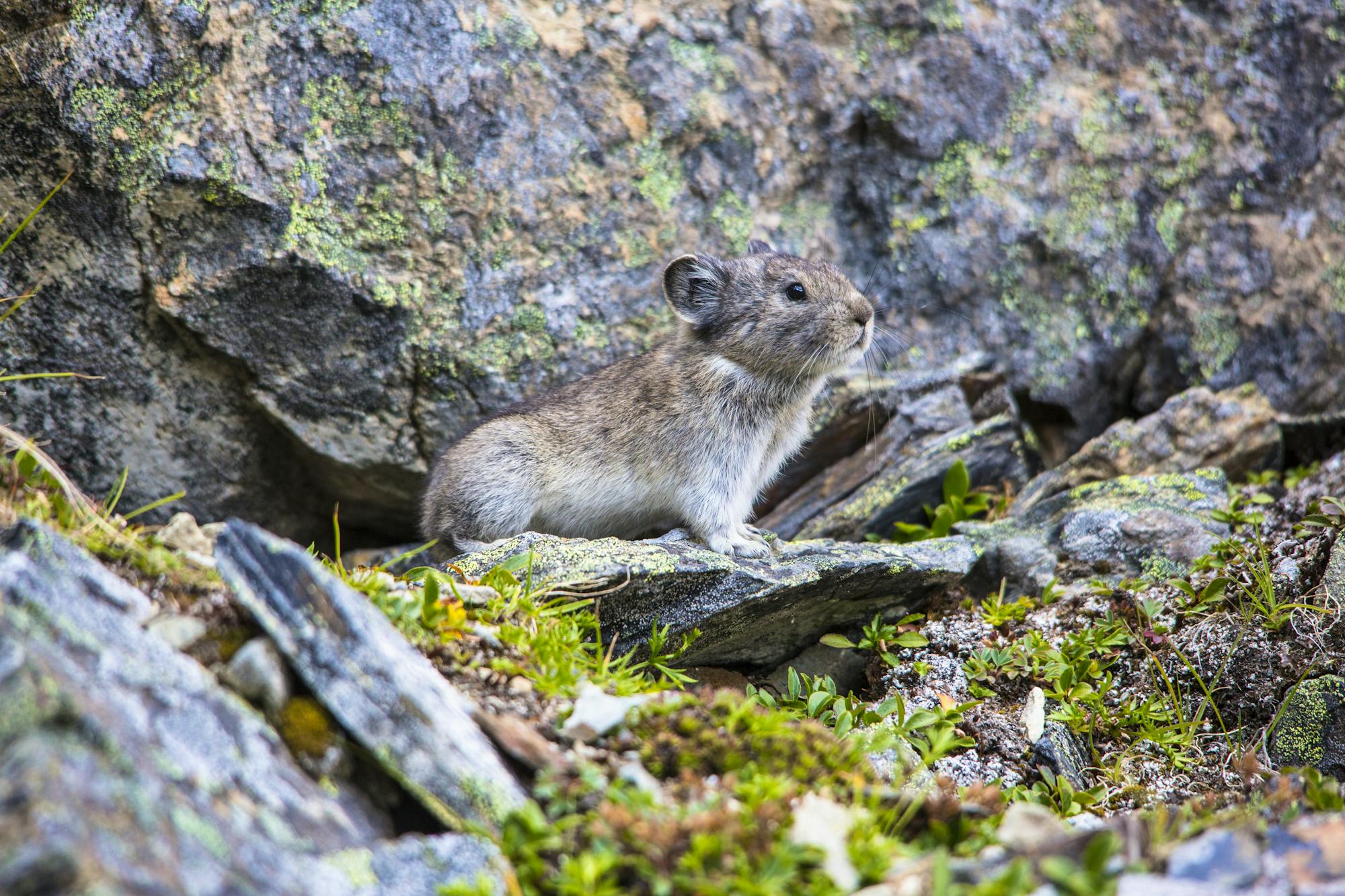Alaska is home to some of the biggest, baddest and most iconic species in North America; from the Pacific walrus and polar bear to the wolverine, muskox and caribou. But which species is the most Alaskan of them all? How about the teeny-tiny, super cute collared pika? Let’s see what this small but mighty contender brings to the table.
There are two pika species found in North America, separated by a gap of about 500 miles across British Columbia and Alberta. American pikas (Ochotona princeps) reside in mountainous western states and provinces of the U.S. and Canada, while collared pikas (Ochotona collaris) live exclusively in Alaska and western Canada.
What’s in a Name
The name “pika” (pronounced pike-uh) comes from the Siberian word “puka,” which means little rock rabbits. Their scientific name, Ochotona collaris, can be broken down: “Ochotona” stems from the Mongolian pika’s common name “ochodona,” while the Latin collaris refers to the collared band around collared pikas’ necks.
The Latin “princeps” in the species name means little prince and may be why the Indigenous Ojibwe (Chippewa) Tribe calls the American pika “little chief hare.”
Small, Mighty, Capable
Collared pikas are lagomorphs and cousins to rabbits and hares. They’re about the size of two tennis balls in both weight — between 100 to 150 grams or 3 to 5 ounces when fully grown — and length. They may be small, but they are truly built for Alaska. Some hikers near the talus slope, or rocky slide areas, of a mountain in Alaska may hear their iconic call, which sounds like a high-pitched bleat of a sheep. Collared pikas are active year-round. They maintain vast networks of travel corridors under the talus rocks to access cached piles of hay they strategically build over the summer months.
American and collared pika have very similar calls. This video shows an American pika calling. Credit: NPS
Pikas are herbivores and forage for vegetation. They stack greens in hay piles under rocks in a way that keeps the greens within view of the sun to dry them out for over-winter storage. They also harvest specific plants at different times as the nutritional value for plants changes throughout their growing seasons. Additionally, since plant toxins serve as a natural preservative, those with high concentrations, like willows, last longer so pikas will store them until late winter after the toxins have broken down.
Living in Sky Islands
Pikas live in small, disconnected “sky islands” of habitat in rocky slopes. Biologists have termed these habitat patches “sky islands” because the valleys in between mountains are as uninhabitable as the sea for small-ranging alpine species like pika.
Adult pikas do not migrate, but juveniles — at just 4 weeks old and the size of one tennis ball — travel an average of 500 meters to establish their new home. Once there, pikas occupy an average range of 200 square meters. Pikas are thus tied closely to their mountain slopes and when their mountain faces challenges, so do they.
A Big Threat
In Alaska, collared pikas are a species of greatest conservation concern under the State Wildlife Action Plan but have no formal designation under the Endangered Species Act. While they do have several natural predators like eagles and weasels, the biggest threat to pikas is climate change.
Pikas are extremely vulnerable to both hot and cold winter temperature changes. According to the U.S. Fish and Wildlife Service, the better-studied American pika can die after a short exposure to ambient temperatures above 78 degrees Fahrenheit. When temperatures do rise above 78 degrees, pikas reduce their activity and retreat behind cool rocks. During this time, they must pause foraging the grasses that sustain them over winter.
Because of this temperature restriction, pikas have evolved to live at higher elevations, especially in the southern parts of their range.
Archaeologists analyzed sites in the Great Basin and discovered pikas have been retreating to higher elevations since the end of the 20th century. The average minimum elevation shifted uphill from historical elevations of 5,700 feet to 8,300 feet. Additionally, over 25% of the Great Basin pika populations studied appear to have been extirpated over the last 30 years. This upslope range contraction in the Great Basin is in response to a warming climate, and specifically, loss of ice and snow.
Similar studies in nearby ranges found a 1,700-foot upward retreat in the elevational range of pikas over the past 90 years. As climate change continues, pikas throughout the west may run out of habitat.
While collared pikas in Alaska benefit from more snow and less heat than their cousins in the lower 48, the Arctic is warming at a rate four times faster than the rest of the world. Join Defenders of Wildlife in committing to and imploring others to reduce carbon emissions. Slowing climate change is our best chance to secure a future for this small but mighty Alaskan icon.









